Spatial Difference and Equity Analysis for Accessibility to Three-Level Medical Services Based on Actual Medical Behavior in Shaanxi, China
Abstract
1. Introduction
2. Materials
2.1. Research Area
2.2. Data Collection
3. Methodology
3.1. Improved Network Analysis Model and Accessibility Calculation
3.1.1. Space-Time Distance Model
3.1.2. Two-Step Floating Catchment Area Method
3.2. Spatial Autocorrelation
3.3. Lorenz Curves and Gini Coefficient
4. Results
4.1. Spatial Difference in Accessibility to Three-Level Medical Services
4.1.1. Spatial Difference in Accessibility to Primary Medical Services
4.1.2. Spatial Difference in Accessibility to Secondary Medical Services
4.1.3. Spatial Difference in Accessibility to Tertiary Medical Services
4.2. Equity in Obtaining Medical Services Based on Accessibility
4.2.1. Equity of Accessibility to Medical Services in Different Areas
4.2.2. Equity of Accessibility to Medical Services in Different Groups
4.3. Sensitivity Analysis of Service Threshold and Service-Capability Weight Setting
5. Discussion
5.1. Improvement in Traffic Conditions Can Reduce Difference in Accessibility to Medical Services
5.2. Improvement in Hospital Service Level Has No Significant Effect on Accessibility Spatial Pattern
5.3. Policy Suggestion
6. Conclusions
Author Contributions
Funding
Institutional Review Board Statement
Informed Consent Statement
Data Availability Statement
Conflicts of Interest
References
- Di, X.; Wang, L.; Dai, X.; Yang, L. Assessing the Accessibility of Home-Based Healthcare Services for the Elderly: A Case from Shaanxi Province, China. Int. J. Environ. Res. Public Health 2020, 17, 7168. [Google Scholar] [CrossRef]
- Liu, S.; Wang, Y.; Zhou, D.; Kang, Y. Two-Step Floating Catchment Area Model-Based Evaluation of Community Care Facilities’ Spatial Accessibility in Xi’an, China. Int. J. Environ. Res. Public Health 2020, 17, 5086. [Google Scholar] [CrossRef] [PubMed]
- Tao, Y.; Shen, Y. Spatial difference of medical facility accessibility and influencing factors: A comparative study of registered and floating populations in Shanghai. Prog. Geogr. 2018, 37, 1075–1085. [Google Scholar]
- Hu, W.; Li, L.; Su, M. Spatial Inequity of Multi-Level Healthcare Services in a Rapid Expanding Immigrant City of China: A Case Study of Shenzhen. Int. J. Environ. Res. Public Health 2019, 16, 3441. [Google Scholar] [CrossRef] [PubMed]
- Rong, P.J.; Zheng, Z.C.; Kwan, M.P.; Qin, Y.C. Evaluation of the spatial equity of medical facilities based on improved potential model and map service API: A case study in Zhengzhou, China. Appl. Geogr. 2020, 119, 102192. [Google Scholar] [CrossRef]
- Gu, X.K.; Tao, S.Y.; Dai, B. Spatial accessibility of country parks in Shanghai, China. Urban Urban Gree 2017, 27, 373–382. [Google Scholar] [CrossRef]
- Cheng, G.; Zeng, X.K.; Duan, L.; Lu, X.P.; Sun, H.C.; Jiang, T.; Li, Y.L. Spatial difference analysis for accessibility to high level hospitals based on travel time in Shenzhen, China. Habitat Int. 2016, 53, 485–494. [Google Scholar] [CrossRef]
- Su, S.L.; Pi, J.H.; Xie, H.; Cai, Z.L.; Weng, M. Community deprivation, walkability, and public health: Highlighting the social inequalities in land use planning for health promotion. Land Use Policy 2017, 67, 315–326. [Google Scholar] [CrossRef]
- Yin, C.H.; He, Q.S.; Liu, Y.F.; Chen, W.Q.; Gao, Y. Inequality of public health and its role in spatial accessibility to medical facilities in China. Appl. Geogr. 2018, 92, 50–62. [Google Scholar] [CrossRef]
- Young, S.G.; Gruca, T.S.; Nelson, G.C. Impact of nonphysician providers on spatial accessibility to primary care in Iowa. Health Serv. Res. 2020, 55, 476–485. [Google Scholar] [CrossRef]
- Nie, Y.F.; Feng, C.C. Research on Accessibility of Medical Treatment Based on Grading Treatment: A Case Study of Weifang City Center Area. Acta Scientarium Naturalium Universitatis Pekinensis 2020, 56, 307–314. [Google Scholar]
- Lu, C.; Zhang, Z.X.; Lan, X.T. Impact of China’s referral reform on the equity and spatial accessibility of healthcare resources: A case study of Beijing. Soc. Sci. Med. 2019, 235, 112386. [Google Scholar] [CrossRef] [PubMed]
- Wang, X.L.; Yang, H.Z.; Duan, Z.Q.; Pan, J. Spatial accessibility of primary health care in China: A case study in Sichuan Province. Soc. Sci. Med. 2018, 209, 14–24. [Google Scholar] [CrossRef] [PubMed]
- Zhan, D.S.; Zhang, W.Z.; Chen, L. Research progress and its enlightenment of urban public service facilities allocation. Prog. Geogr. 2019, 38, 506–519. [Google Scholar]
- Guzman, L.A.; Oviedo, D.; Rivera, C. Assessing equity in transport accessibility to work and study: The Bogota region. J. Transp. Geogr. 2017, 58, 236–246. [Google Scholar] [CrossRef]
- Xu, M.Y.; Xin, J.; Su, S.L.; Weng, M.; Cai, Z.L. Social inequalities of park accessibility in Shenzhen, China: The role of park quality, transport modes, and hierarchical socioeconomic characteristics. J. Transp. Geogr. 2017, 62, 38–50. [Google Scholar] [CrossRef]
- Chang, Z.; Chen, J.Y.; Li, W.F.; Li, X. Public transportation and the spatial inequality of urban park accessibility: New evidence from Hong Kong. Transp. Res. Part D Transp. Environ. 2019, 76, 111–122. [Google Scholar] [CrossRef]
- Boisjoly, G.; Serra, B.; Oliveira, G.T.; El-Geneidy, A. Accessibility measurements in Sao Paulo, Rio de Janeiro, Curitiba and Recife, Brazil. J. Transp. Geogr. 2020, 82, 102551. [Google Scholar] [CrossRef]
- Kimpton, A. A spatial analytic approach for classifying greenspace and comparing greenspace social equity. Appl. Geogr. 2017, 82, 129–142. [Google Scholar] [CrossRef]
- Tan, P.Y.; Samsudin, R. Effects of spatial scale on assessment of spatial equity of urban park provision. Landsc. Urban Plan. 2017, 158, 139–154. [Google Scholar] [CrossRef]
- Carpentieri, G.; Guida, C.; Masoumi, H.E. Multimodal Accessibility to Primary Health Services for the Elderly: A Case Study of Naples, Italy. Sustainability 2020, 12, 781. [Google Scholar] [CrossRef]
- Zeng, W.; Xiang, L.L.; Zhang, X.L. Research in spatial pattern of accessibility to community service facilities and spatial deprivation of low incone community in nanjing. Human Geogr. 2017, 32, 73–81. [Google Scholar]
- Li, X.W.; Bai, J.J.; Tang, S.H. Impact of High-Speed Rail Network Construction on the Spatial Pattern of Accessibility in Shaanxi Province. Econ. Geogr. 2019, 39, 82–92. [Google Scholar]
- Xiao, Y.; Wang, Z.; Li, Z.G.; Tang, Z.L. An assessment of urban park access in Shanghai—Implications for the social equity in urban China. Landsc. Urban Plan. 2017, 157, 383–393. [Google Scholar] [CrossRef]
- Zhu, Y.W.; Bai, Y.H.; Lu, L. Application of the case classification principle in establishment of the two-way referral index system. Chin. Health Resour. 2013, 16, 258–260. [Google Scholar]
- Jiao, J.J.; Wang, J.; Jin, F.J.; Dunford, M. Impacts on accessibility of China’s present and future HSR network. J. Transp. Geogr. 2014, 40, 123–132. [Google Scholar] [CrossRef]
- Pan, J.; Zhao, H.Q.; Wang, X.L.; Shi, X. Assessing spatial access to public and private hospitals in Sichuan, China: The influence of the private sector on the healthcare geography in China. Soc. Sci. Med. 2016, 170, 35–45. [Google Scholar] [CrossRef]
- Mao, K.N.; Chen, Y.H.; Wu, G.H.; Huang, J.W.; Yang, W.Y.; Xia, Z.L. Measuring Spatial Accessibility of Urban Fire Services Using Historical Fire Incidents in Nanjing, China. ISPRS Int. J. Geo-Inf. 2020, 9, 585. [Google Scholar] [CrossRef]
- Zheng, Z.C.; Xia, H.M.; Ambinakudige, S.; Qin, Y.C.; Li, Y.; Xie, Z.X.; Zhang, L.J.; Gu, H.B. Spatial Accessibility to Hospitals Based on Web Mapping API: An Empirical Study in Kaifeng, China. Sustainability 2019, 11, 1160. [Google Scholar] [CrossRef]
- Qian, T.L.; Chen, J.; Li, A.; Wang, J.C.; Shen, D.T. Evaluating Spatial Accessibility to General Hospitals with Navigation and Social Media Location Data: A Case Study in Nanjing. Int. J. Environ. Res. Public Health 2020, 17, 2752. [Google Scholar] [CrossRef]
- Tao, Z.L.; Cheng, Y.; Dai, T.Q. Measuring spatial accessibility to residential care facilities in Beijing. Prog. Geogr. 2014, 33, 616–624. [Google Scholar]
- Cao, X.S.; Zhang, H.L.; Li, T.; Ma, W. Multi-Scale Analysis of the Effect of High-Speed Railway on Accessibility of Guanzhong Plain Urban Agglomeration. Econ. Geogr. 2018, 38, 60–67. [Google Scholar]
- Lyu, M.J.; Cao, X.S. The Spatial Characteristics of Rurality and Its Relationship with the Transportation Accessibility in the Loess Plateau. Sci. Geogr. Sin. 2020, 40, 248–260. [Google Scholar]
- Horcher, D.; Graham, D.J. The Gini index of demand imbalances in public transport. Transportation 2020. [Google Scholar] [CrossRef]
- Delbosc, A.; Currie, G. Using Lorenz curves to assess public transport equity. J. Transp. Geogr. 2011, 19, 1252–1259. [Google Scholar] [CrossRef]
- Lucas, K.; van Wee, B.; Maat, K. A method to evaluate equitable accessibility: Combining ethical theories and accessibility-based approaches. Transportation 2016, 43, 473–490. [Google Scholar] [CrossRef]
- Chan, W.C.; Wan Ibrahim, W.H.; Lo, M.C.; Suaidi, M.K.; Ha, S.T. Sustainability of Public Transportation: An Examination of User Behavior to Real-Time GPS Tracking Application. Sustainability 2020, 12, 9541. [Google Scholar] [CrossRef]
- Liu, L.W.; Zhang, M. High-speed rail impacts on travel times, accessibility, and economic productivity: A benchmarking analysis in city-cluster regions of China. J. Transp. Geogr. 2018, 73, 25–40. [Google Scholar] [CrossRef]
- Kelobonye, K.; McCarney, G.; Xia, J.; Swapan, M.S.H.; Mao, F.; Zhou, H. Relative accessibility analysis for key land uses: A spatial equity perspective. J. Transp. Geogr. 2019, 75, 82–93. [Google Scholar] [CrossRef]
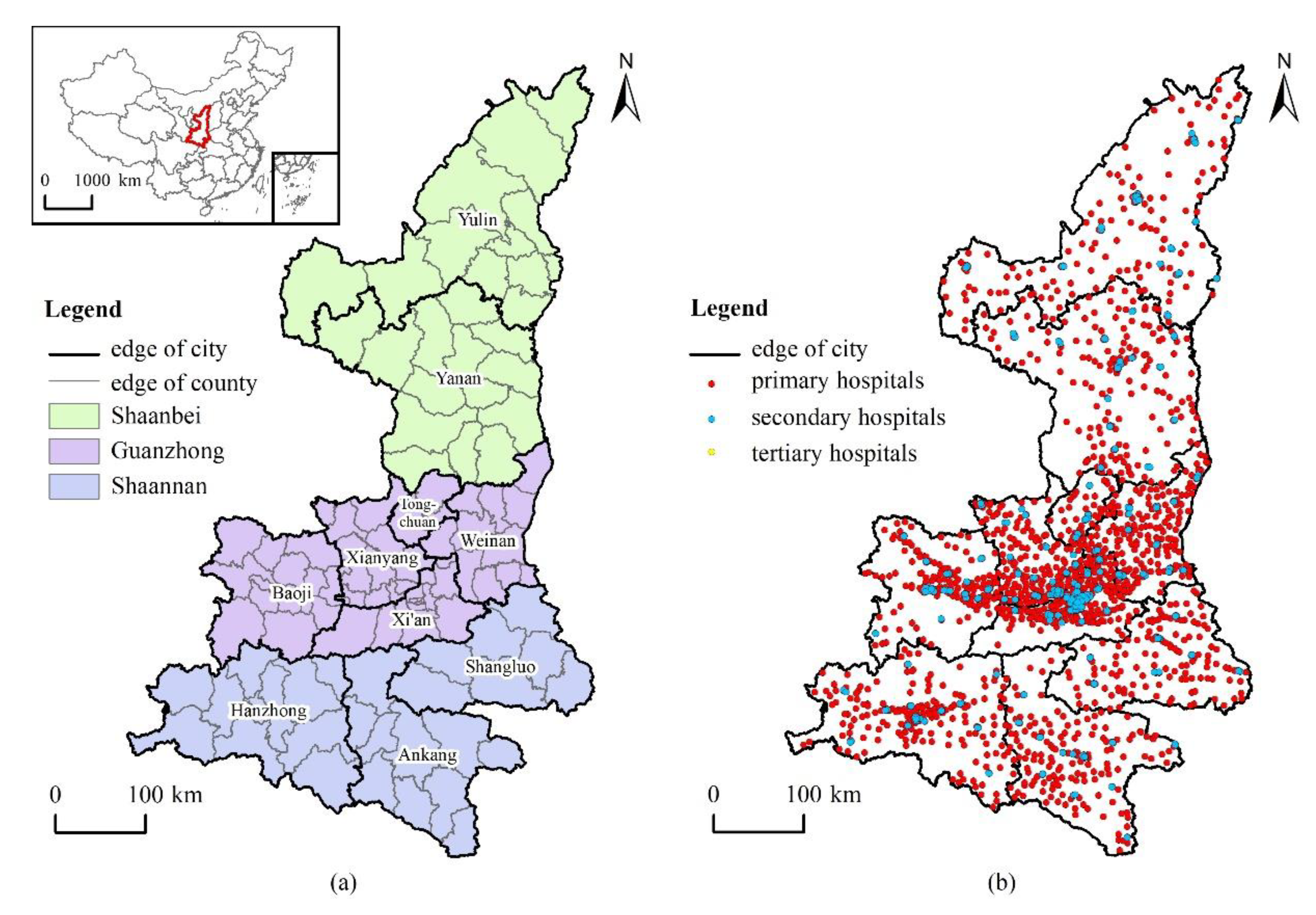
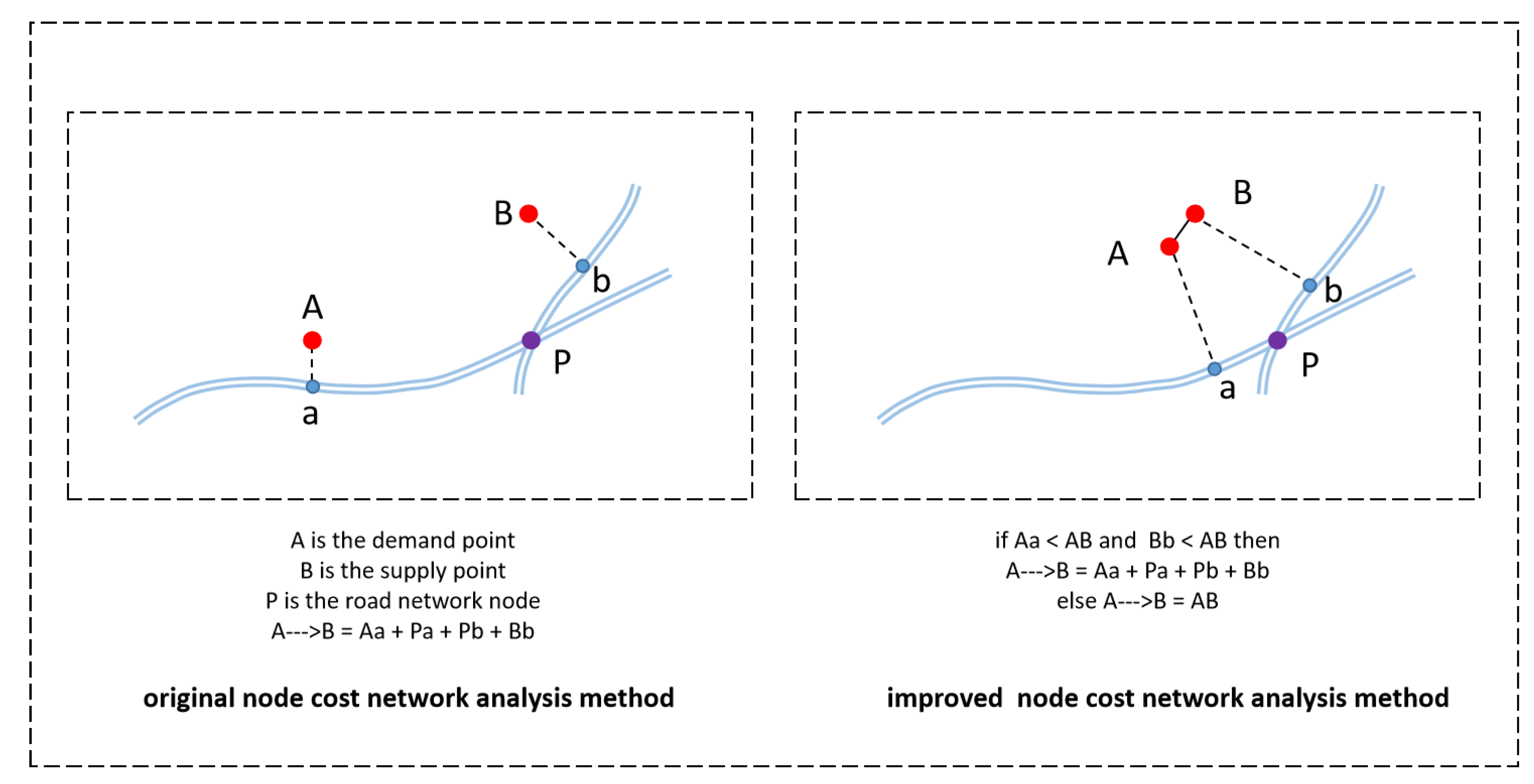
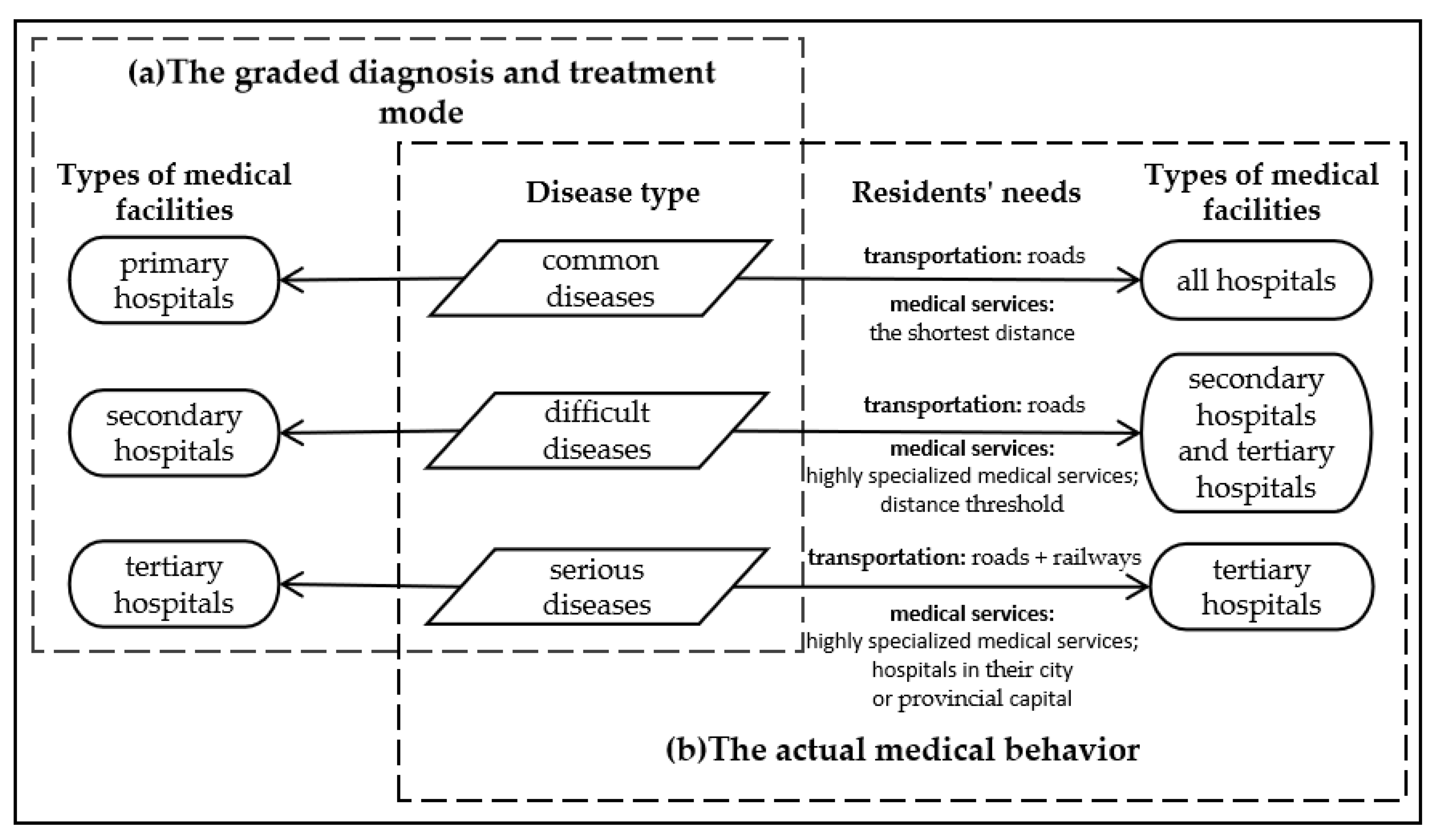
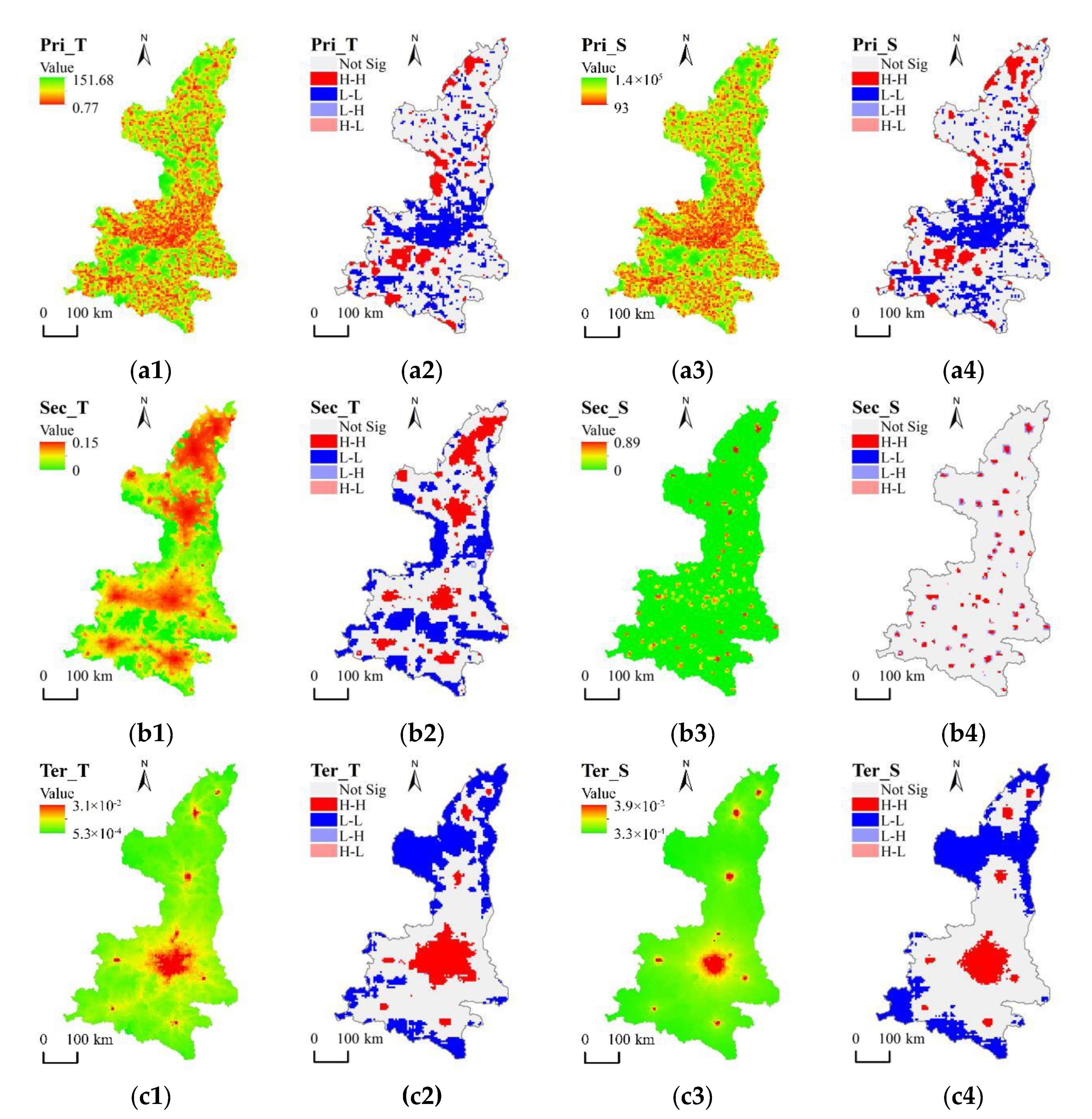
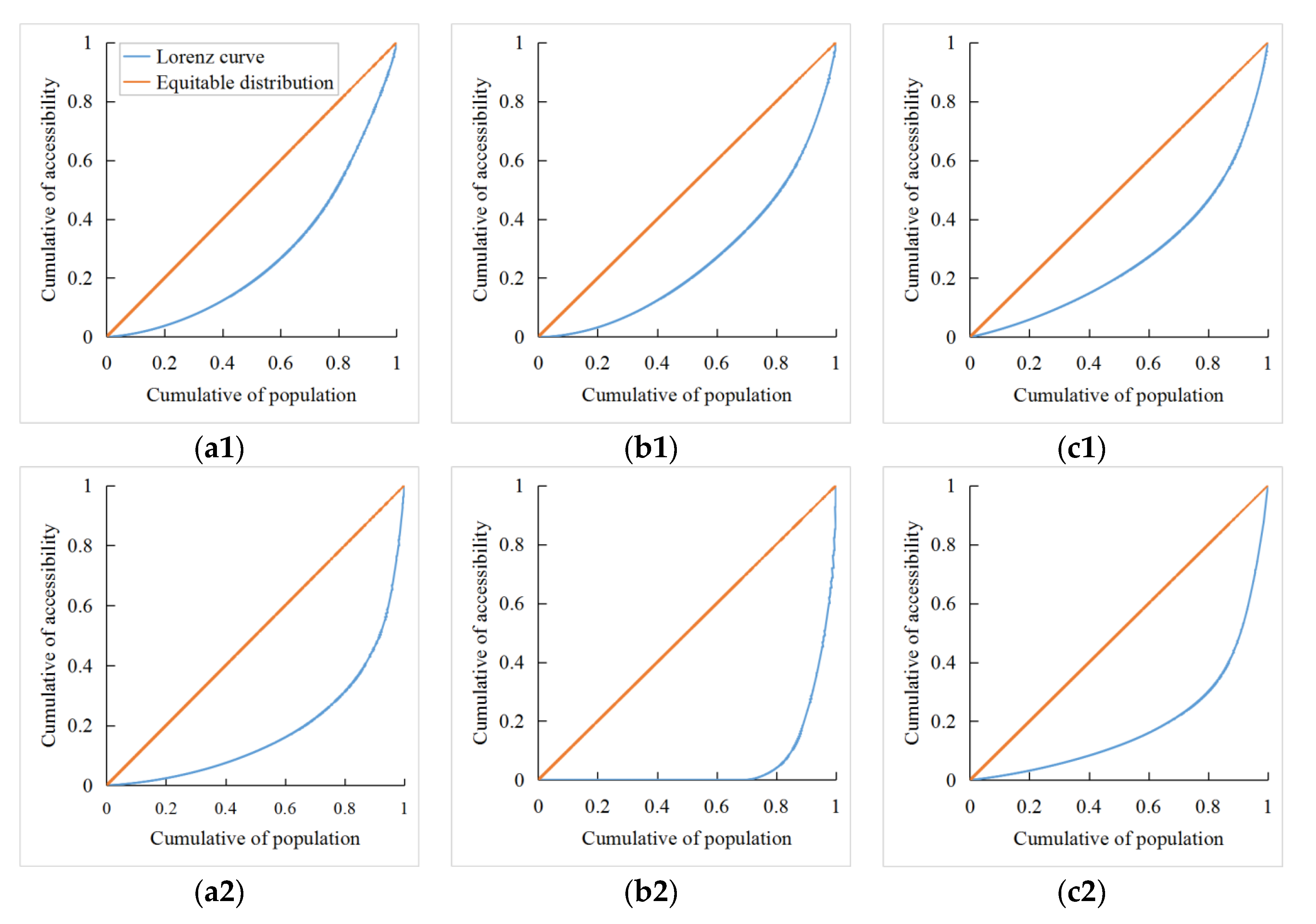
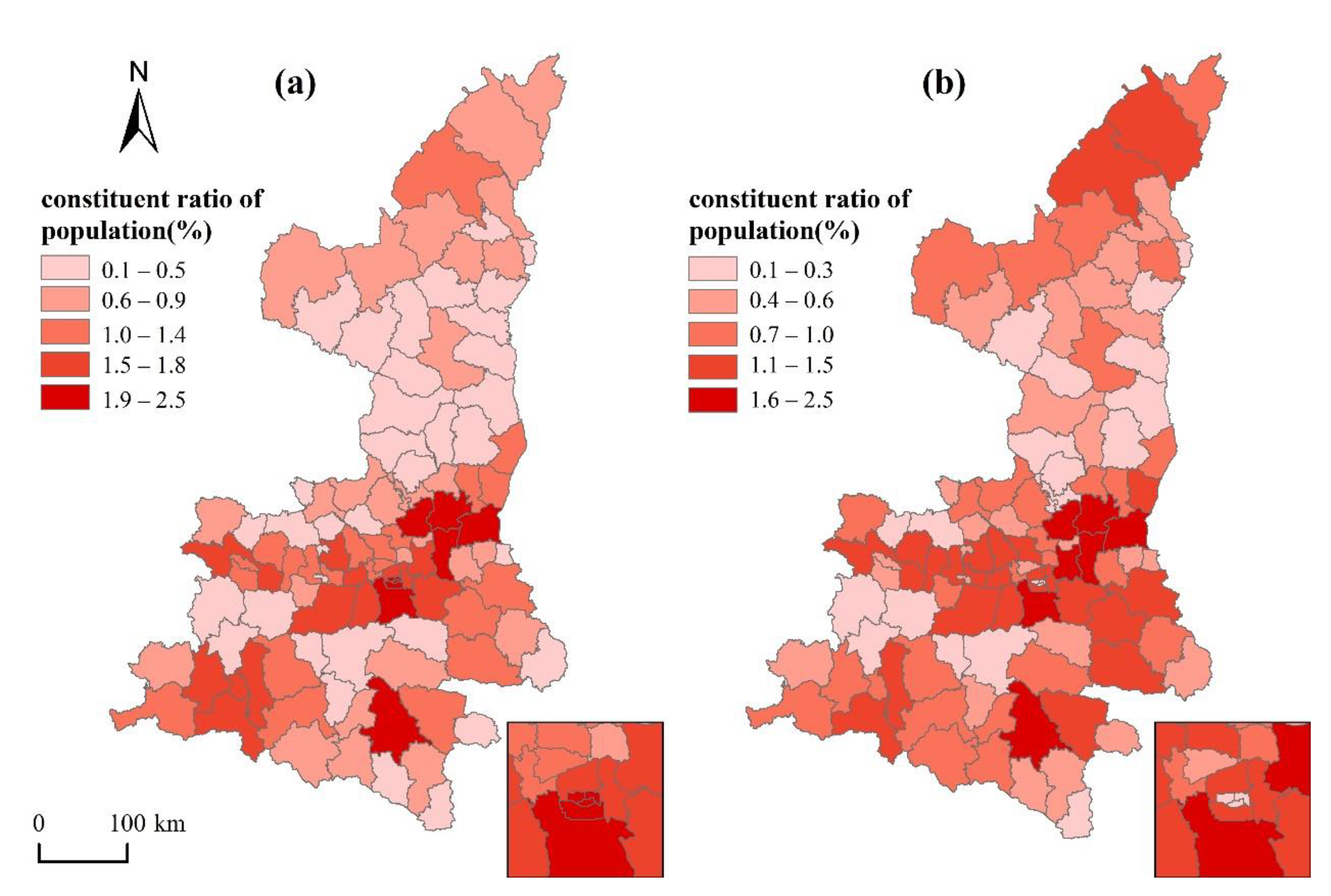



| Region | Pri_T | Sec_T | Ter_T | |||||||||
| Max | Min | Mean | Moran’ I | Max | Min | Mean | Moran’ I | Max | Min | Mean | Moran’ I | |
| Province | 151.68 | 0.77 | 23.90 | 0.742 | 0.15 | 0 | 4.7 × 10−3 | 0.830 | 3.1 × 10−2 | 5.3 × 10−4 | 1.7 × 10−3 | 0.847 |
| Guanzhong | 132.13 | 1.12 | 18.88 | 0.762 | 0.05 | 0 | 4.8 × 10−3 | 0.819 | 2.1 × 10−2 | 9.1 × 10−4 | 2.5 × 10−3 | 0.913 |
| Shaanbei | 140.87 | 1.56 | 27.14 | 0.706 | 0.15 | 0 | 6.0 × 10−3 | 0.829 | 3.1 × 10−2 | 5.5 × 10−4 | 1.3 × 10−3 | 0.688 |
| Shaannan | 151.68 | 0.77 | 24.13 | 0.728 | 0.07 | 0 | 3.4 × 10−3 | 0.828 | 1.7 × 10−2 | 5.3 × 10−4 | 1.6 × 10−3 | 0.670 |
| Region | Pri_S | Sec_S | Ter_S | |||||||||
| Max | Min | Mean | Moran’ I | Max | Min | Mean | Moran’ I | Max | Min | Mean | Moran’ I | |
| Province | 1.4 × 105 | 93 | 1.1 × 104 | 0.757 | 0.89 | 0 | 3.9 × 10−3 | 0.530 | 3.9 × 10−2 | 3.3 × 10−4 | 1.2 × 10−3 | 0.768 |
| Guanzhong | 1.4 × 105 | 93 | 8.6 × 103 | 0.672 | 0.30 | 0 | 3.2 × 10−3 | 0.365 | 3.3 × 10−2 | 5.1 × 10−4 | 1.8 × 10−3 | 0.860 |
| Shaanbei | 6.4 × 104 | 223 | 1.3 × 104 | 0.767 | 0.89 | 0 | 4.9 × 10−3 | 0.467 | 3.9 × 10−2 | 3.3 × 10−4 | 0.8 × 10−3 | 0.680 |
| Shaannan | 7.9 × 104 | 121 | 1.0 × 104 | 0.764 | 0.48 | 0 | 3.1 × 10−3 | 0.563 | 3.5 × 10−2 | 4.0 × 10−4 | 1.0 × 10−3 | 0.576 |
| Region | Pri_T | Pri_S | Sec_T | Sec_S | Ter_T | Ter_S |
|---|---|---|---|---|---|---|
| Province | 0.446 | 0.636 | 0.471 | 0.883 | 0.457 | 0.623 |
| Guanzhong | 0.392 | 0.613 | 0.436 | 0.816 | 0.414 | 0.577 |
| Shaanbei | 0.442 | 0.492 | 0.518 | 0.985 | 0.257 | 0.409 |
| Shaannan | 0.459 | 0.532 | 0.479 | 0.961 | 0.215 | 0.332 |
| Accessibility | Province | Shaannan | ||
|---|---|---|---|---|
| Aging Population | Agricultural Population | Aging Population | Agricultural Population | |
| Pri_T | −0.102 | 0.327 ** | 0.199 | 0.241 |
| Pri_S | −0.114 | 0.338 ** | 0.241 | 0.210 |
| Sec_T | 0.079 | −0.754 ** | −0.101 | −0.754 ** |
| Sec_S | 0.131 | −0.829 ** | −0.218 | −0.798 ** |
| Ter_T | 0.156 | −0.747 ** | −0.417 * | −0.558 ** |
| Ter_S | 0.164 | −0.752 ** | −0.510 * | −0.519 * |
| Guanzhong | Shaanbei | |||
| Aging Population | Agricultural Population | Aging Population | Agricultural Population | |
| Pri_T | −0.203 | 0.331 * | 0.072 | −0.282 |
| Pri_S | −0.230 | 0.376 ** | 0.253 | −0.161 |
| Sec_T | 0.398 ** | −0.773 ** | −0.339 | −0.333 |
| Sec_S | 0.468 ** | −0.854 ** | −0.426 * | −0.582 ** |
| Ter_T | 0.339 * | −0.761 ** | −0.306 | −0.654 ** |
| Ter_S | 0.351 ** | −0.762 ** | −0.385 | −0.662 ** |
| Accessibility | Tolerance | Weight | |||||
|---|---|---|---|---|---|---|---|
| T = 90 | T = 120 | T = 150 | W = 1.5 | W = 2 | W = 2.5 | ||
| Percentile (%) | 10 | 0 | 1.6 × 10−4 | 5.3 × 10−4 | 1.6 × 10−4 | 1.6 × 10−4 | 1.6×10−4 |
| 20 | 2.5 × 10−4 | 8.7 × 10−4 | 1.5 × 10−3 | 8.5 × 10−4 | 8.7 × 10−4 | 8.8×10−4 | |
| 30 | 9.1 × 10−4 | 1.6 × 10−3 | 2.4 × 10−3 | 1.5 × 10−3 | 1.6 × 10−3 | 1.6×10−3 | |
| 40 | 1.5 × 10−3 | 2.3 × 10−3 | 3.1 × 10−3 | 2.1 × 10−3 | 2.3 × 10−3 | 2.4 × 10−3 | |
| 50 | 2.0 × 10−3 | 3.1 × 10−3 | 3.7 × 10−3 | 2.8 × 10−3 | 3.1 × 10−3 | 3.5 × 10−3 | |
| 60 | 2.9 × 10−3 | 3.9 × 10−3 | 4.4 × 10−3 | 3.5 × 10−3 | 3.9 × 10−3 | 4.5 × 10−3 | |
| 70 | 4.1 × 10−3 | 5.0 × 10−3 | 5.1 × 10−3 | 4.4 × 10−3 | 5.0 × 10−3 | 5.8 × 10−3 | |
| 80 | 5.8 × 10−3 | 6.2 × 10−3 | 6.1 × 10−3 | 5.4 × 10−3 | 6.2 × 10−3 | 7.4 × 10−3 | |
| 90 | 8.5 × 10−3 | 8.1 × 10−3 | 7.6 × 10−3 | 7.0 × 10−3 | 8.1 × 10−3 | 9.6 × 10−3 | |
| 100 | 2.0 × 10−2 | 1.6 × 10−2 | 1.4 × 10−2 | 1.4 × 10−2 | 1.6 × 10−2 | 2.0 × 10-2 | |
| max | 0.20 | 0.15 | 0.12 | 0.12 | 0.15 | 0.18 | |
| min | 0 | 0 | 0 | 0 | 0 | 0 | |
| mid | 2.4 × 10−3 | 3.5 × 10−3 | 4.0 × 10−3 | 3.2 × 10−3 | 3.5 × 10−3 | 4.0 × 10−3 | |
| mean | 4.6 × 10−3 | 4.7 × 10−3 | 4.9 × 10−3 | 4.1 × 10−3 | 4.7 × 10−3 | 5.5 × 10−3 | |
| std | 7.7 × 10−3 | 5.9 × 10−3 | 4.9 × 10−3 | 4.8 × 10−3 | 5.9 × 10−3 | 7.2 × 10−3 | |
Publisher’s Note: MDPI stays neutral with regard to jurisdictional claims in published maps and institutional affiliations. |
© 2020 by the authors. Licensee MDPI, Basel, Switzerland. This article is an open access article distributed under the terms and conditions of the Creative Commons Attribution (CC BY) license (http://creativecommons.org/licenses/by/4.0/).
Share and Cite
Wang, K.; Bai, J.; Dang, X. Spatial Difference and Equity Analysis for Accessibility to Three-Level Medical Services Based on Actual Medical Behavior in Shaanxi, China. Int. J. Environ. Res. Public Health 2021, 18, 112. https://doi.org/10.3390/ijerph18010112
Wang K, Bai J, Dang X. Spatial Difference and Equity Analysis for Accessibility to Three-Level Medical Services Based on Actual Medical Behavior in Shaanxi, China. International Journal of Environmental Research and Public Health. 2021; 18(1):112. https://doi.org/10.3390/ijerph18010112
Chicago/Turabian StyleWang, Kan, Jianjun Bai, and Xing Dang. 2021. "Spatial Difference and Equity Analysis for Accessibility to Three-Level Medical Services Based on Actual Medical Behavior in Shaanxi, China" International Journal of Environmental Research and Public Health 18, no. 1: 112. https://doi.org/10.3390/ijerph18010112
APA StyleWang, K., Bai, J., & Dang, X. (2021). Spatial Difference and Equity Analysis for Accessibility to Three-Level Medical Services Based on Actual Medical Behavior in Shaanxi, China. International Journal of Environmental Research and Public Health, 18(1), 112. https://doi.org/10.3390/ijerph18010112





